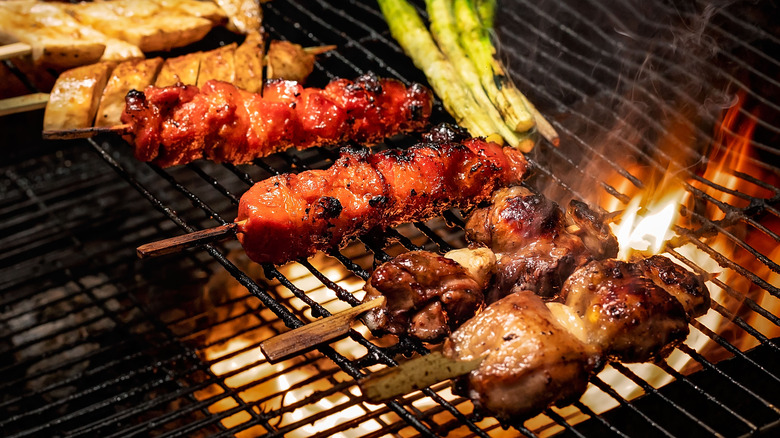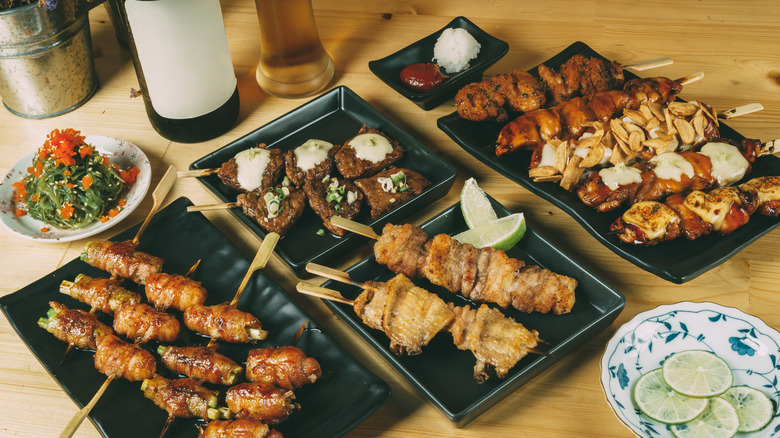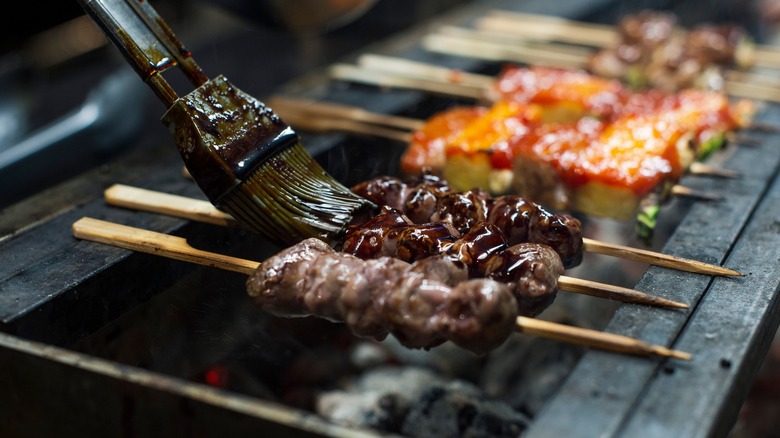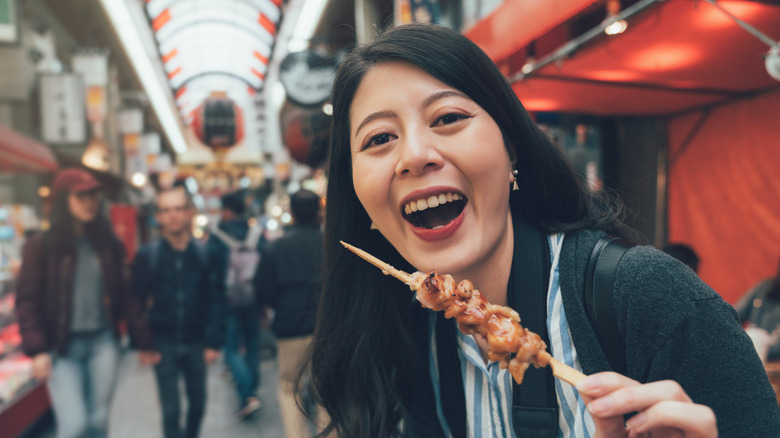Yakitori: A Japanese Street Food With A Rich Tradition
Most culinary cultures have their versions of skewered and grilled meat that are served as street food, and Japan is no exception. A staple in Japanese cuisine, yakitori is served everywhere, from street stalls to high-end restaurants to traditional pubs called izakayas. More specifically, it's a hallmark of the izakaya culture of casual and communal drinking where locals stop at a bar for some beer or sake and sticks of yakitori on their way home from work.
Today in the West, yakitori has taken to mean any type of meat that's skewered and grilled, from beef to pork to chicken. Traditionally, however, it refers to grilled chicken, as the direct translation of its name implies: 'yaki,' which means 'to grill' and 'tori,' which means 'bird.' Grilled skewered beef and pork fall under the broader term kushiyaki, which also includes all types of skewered meat including offal, seafood, and vegetables.
While it's ubiquitous now, yakitori took a while to take hold among the Japanese. Japan was traditionally a Buddhist country, and eating meat was prohibited during the Edo Period, which lasted from 1603 to 1868. The restriction was more stringent against eating pork and beef — although consuming chicken was also looked down upon. The only sources of meat that were deemed acceptable were wild birds (quail, pheasants), ducks, and sparrows, which people would hunt and cook by skewering. This was the earliest form of yakitori, and the cooking style was first mentioned in a 1682 cookbook.
The high cost of chicken meat led to the use of offal
During the less prohibitive Meiji Period that followed the Edo Period, meat consumption was no longer taboo, yet the cultural and religious stigma against it lingered. Street vendors still felt the need to mask the scent of cooking meat by grilling chicken over charcoal and coating it with sauce.
Because chicken consumption hadn't been the norm for centuries, there weren't enough farmers raising them for food. The most available breed was the shamo, a tough and muscular local fighting rooster whose meat needed to be stewed in hotpots, so it would be tender enough to eat. The limited supply made chicken meat expensive, so vendors also offered skewers of beef, pork, and chicken offal as well as boar meat. Eating offal ('horumon') was part of the Japanese dining culture, driven by food scarcity and rooted in their disdain for wasteful consumption.
It wasn't until the 1950s, after the U.S. introduced broiler chickens to the country, that chicken farming became widespread. With chicken meat becoming more affordable, 'yatai' or street food stalls began popping up. Sellers would set up shop strategically along the routes that ordinary Japanese employees or salarymen would take going home from work.
As yakitori became more popular, the quality of the meat became the focus, both for public health concerns and to satisfy the customers' palate. More farms began raising 'jidori,' the local premium breed of chicken that's known for its rich and chewy flesh.
Meat is just one of the three pillars of yakitori
While yakitori is nothing more complicated than cooking food in direct heat, each element involved must be of quality. Aside from using premium meat, yakitori chefs choose from two kinds of seasoning to flavor the food. First is Japanese tare sauce. Each chef has their own recipe — although the basic ingredients are soy sauce, sake, mirin, vinegar, sugar, and ginger. The mixture is reduced to achieve a syrupy consistency, with all traces of the sake's alcohol taste removed.
This flavorful concoction is used to baste and dip the skewered meat toward the end of the grilling process, with each skewer flipped every few minutes for basting. The second seasoning is simply salt that's sprinkled over the meat as it is grilled to create the yakitori flavor called shio. Shio lets the flavor of beef, pork, and chicken shine through while tare adds a delicious caramelization.
The third element is the charcoal used. Chefs prefer binchōtan charcoal made from the dense Japanese Ubame oak since it is believed to sustain temperatures of over 1,800 degrees Fahrenheit over a long period of grilling.
Because of the time needed to cut and prepare the meat for skewering and to get the grill going, most of the quality yakitori places in Japan open in the late afternoon. The wait is worth it, though, especially for folks who need some beer and delicious meat after a long day at work.
Yakitori's convenience made it a staple in Japan's street food scene
Yakitori's delicious simplicity and convenience have made it a popular street food favorite along with takoyaki, but Japanese street food culture isn't like what you might imagine. After the Edo Period, yatai flourished across Japan, feeding busy workers and serving as a precursor to the modern-day fast-food dining model.
During the lead-up to the 1964 Summer Olympics in Tokyo, however, the government cracked down on them to improve the country's image to international visitors. Most in the northern region of the country closed down, leading to the concentrated number of yatai operating in specific areas in the south. Today, the Nakasu, Tenjin, and Nagahama districts in Fukuoka still serve as the center of Japan's street food scene. The stalls open in the evening and stay busy through the night as a parade of locals and tourists come in for quick bites before hopping to the next stall.
Outside these districts, street food is enjoyed more during festivals known as 'matsuri.' Walking around while eating is usually seen as improper behavior in Japanese culture, but it's welcomed during a matsuri, and yakitori's bite-sized pieces serve as the perfect portable food. Sellers also use bamboo skewers that have one end wider and flattened so they're easy to grip.
Both a witness to and a product of Japan's progress, yakitori has evolved from a taboo dish to a timeless delicacy. It's enjoyable whether eaten outdoors or in a high-end restaurant.



